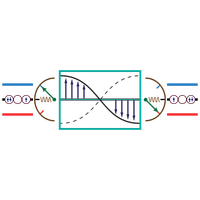Cavity-Mediated Entanglement of Parametrically Driven Spin Qubits via Sidebands
引用次数: 0
Abstract
We consider a pair of quantum dot-based spin qubits that interact via microwave photons in a superconducting cavity and that are also parametrically driven by separate external electric fields. For this system, we formulate a model for spin qubit entanglement in the presence of mutually off-resonant qubit and cavity frequencies. We show that the sidebands generated via the driving fields enable highly tunable qubit-qubit entanglement using only ac control and without requiring the qubit and cavity frequencies to be tuned into simultaneous resonance. The model we derive can be mapped to a variety of qubit types, including detuning-driven one-electron spin qubits in double quantum dots and three-electron resonant exchange qubits in triple quantum dots. The high degree of nonlinearity inherent in spin qubits renders these systems particularly favorable for parametric drive-activated entanglement. We determine multiple common resonance conditions for the two driven qubits and the cavity and identify experimentally relevant parameter regimes that enable the implementation of entangling gates with suppressed sensitivity to cavity photon occupation and decay. The parametrically driven sideband resonance approach that we describe provides a promising route toward scalability and modularity in spin-based quantum information processing through drive-enabled tunability that can also be implemented in micromagnet-free electron and hole systems for spin-photon coupling.

通过边带实现腔室介导的参量驱动自旋丘比特纠缠
我们考虑了一对基于量子点的自旋量子比特,它们通过超导腔中的微波光子进行相互作用,并由独立的外部电场参数驱动。对于这个系统,我们提出了一个自旋量子比特纠缠模型,它适用于自旋量子比特和腔体频率互不共振的情况。我们的研究表明,通过驱动电场产生的边带可以实现高度可调的量子比特-量子比特纠缠,只需使用交流控制,而无需将量子比特和空腔频率同时调谐到共振状态。我们推导出的模型可以映射到各种类型的量子比特,包括双量子点中的失谐驱动单电子自旋量子比特和三量子点中的三电子共振交换量子比特。自旋量子比特固有的高度非线性使这些系统特别有利于参数驱动激活的纠缠。我们确定了两个被驱动的量子比特和空腔的多个共振条件,并确定了与实验相关的参数区,从而能够实现对空腔光子占据和衰变敏感性受到抑制的纠缠门。我们描述的参数驱动边带共振方法通过驱动可调性,为基于自旋的量子信息处理的可扩展性和模块化提供了一条很有前途的途径,这种方法也可以在用于自旋光子耦合的无微磁电子和空穴系统中实现。
本文章由计算机程序翻译,如有差异,请以英文原文为准。
求助全文
约1分钟内获得全文
求助全文

 求助内容:
求助内容: 应助结果提醒方式:
应助结果提醒方式:


